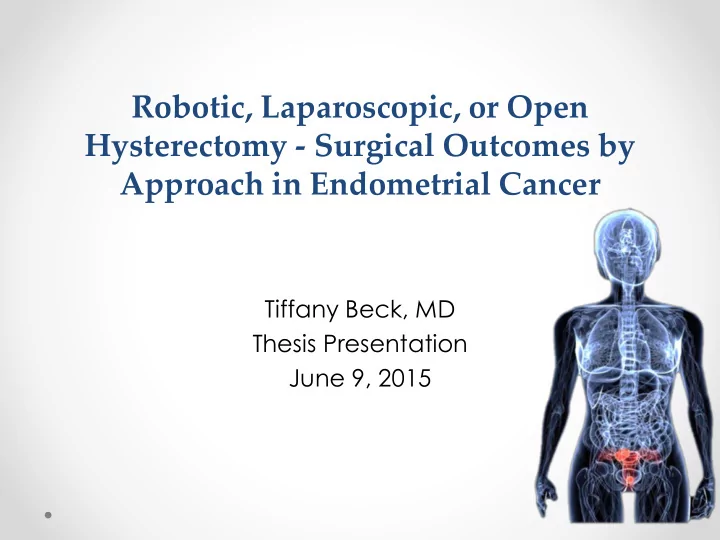

Robotic, Laparoscopic, or Open Hysterectomy - Surgical Outcomes by Approach in Endometrial Cancer Tiffany Beck, MD Thesis Presentation June 9, 2015
Background • Endometrial Cancer is the most common GYN malignancy • Minimally invasive surgery (laparoscopy) compared to traditional laparotomy o Equivalent evaluation & treatment of cancer o Fewer complications o Lower cost o Faster recovery This study was supported by the Maternal and Child Health Bureau, grant #T76MC00011
Background • Robotic Assisted(RA)Surgery in Gynecology o Increasingly available across the US o Conflicting evidence regarding benefits • Studies of RA surgery in Gynecologic Cancer are limited • Appropriate comparison group This study was supported by the Maternal and Child Health Bureau, grant #T76MC00011
Among women with endometrial cancer managed surgically from 2008-2011 • Aim 1: Describe trends of surgical approach over time • Aim 2: Determine if length of stay differs by surgical approach • Aim 3: Determine if hospital readmissions differ by surgical approach This study was supported by the Maternal and Child Health Bureau, grant #T76MC00011
Methods • Population-based retrospective cohort study • Study Population o Female patients ≥18 years old o Endometrial cancer treated surgically o Washington State from 2008-2011 • Data Source o Comprehensive Hospital Abstract Reporting System (CHARS) o Patients identified through ICD9 codes for diagnosis and procedure • RA surgery ICD9 code 2008 This study was supported by the Maternal and Child Health Bureau, grant #T76MC00011
Methods • Exposure of Surgical Approach o Laparotomy (Standard of Care, referent group) o Laparoscopy o RA surgery • Primary Outcomes o Surgical trends over time o Length of Stay (LOS) o Readmission Rate (30, 60, 90 days) • Linked records for up to 4 total admission This study was supported by the Maternal and Child Health Bureau, grant #T76MC00011
Analysis • Descriptive Statistics by Surgical Group o Baseline demographics o Preoperative comorbidities • Multivariable Analysis o Trends for surgical approach over time - linear regression This study was supported by the Maternal and Child Health Bureau, grant #T76MC00011
Analysis • Multivariable Analysis o Differences in hospital LOS - linear regression to estimate change in mean number of days with 95% confidence intervals (CI) o Difference in frequency of readmissions - logistic regression to estimate odds ratios (95% CI) This study was supported by the Maternal and Child Health Bureau, grant #T76MC00011
Analysis • Important Covariates o Charlson Comorbidity Index o Surgical complexity – Lymph Node Dissection (LND) • Additionally evaluated covariates • Age • Obesity • Diabetes • Year of surgery • Tobacco All analysis adjusted for year of surgery, CCI, and LND • This study was supported by the Maternal and Child Health Bureau, grant #T76MC00011
Results This study was supported by the Maternal and Child Health Bureau, grant #T76MC00011
Results Robotic Laparoscopic Laparotomy n=1,003 (%) n=284 (%) n=971 (%) Age <45 61 (6.1) 17 (6.0) 49 (5.1) 45-55 202 (20.1) 71 (25.0) 217 (22.4) 56-65 365 (36.4) 96 (33.8) 351 (36.2) >65 375 (37.4) 100 (35.2) 354 (36.5) Obese 322 (32.1) 100 (35.2) 280 (28.8) 4 (1.9) BMI 25-29 2 (4.8) 2 (1.2) 19 (8.8) BMI 30-34.9 4 (9.5) 7 (4.3) 37 (17.1) BMI 35 – 39.9 8 (19.0) 15 (9.2) 156 (72.2) BMI ≥40 ‡ 28 (66.7) 139 (85.3) CCI a 0-1 917 (91.4) 263 (92.6) 851 (87.6) ≥2 86 (8.6) 21 (7.4) 120 (12.4) This study was supported by the Maternal and Child Health Bureau, grant #T76MC00011
Surgical Trends 100 90 80 70 60 % 50 Laparoscopy 40 Laparotomy 30 RA 20 10 0 2008 2009 2010 2011 Year of Surgery This study was supported by the Maternal and Child Health Bureau, grant #T76MC00011
Length of Stay • Mean LOS o 2.7 days shorter for RA surgery compared to laparotomy (95% CI: 2.5-2.9 days) o 2.5 days shorter for LS compared to laparotomy (95% CI: 2.2-2.8 days) This study was supported by the Maternal and Child Health Bureau, grant #T76MC00011
Readmissions RA Surgery LS Laparotomy (N=1003) (N=284) (N=971) N (%) OR (95% CI) N (%) OR (95% CI) N (%) Any 81 (8.1) 0.5 (0.3, 0.6) 28 (9.9) 0.7 (0.5, 1.1) 144 (14.8) -ref- Timing 0-30 45 (4.5) 0.4 (0.3, 0.6) 17 (6.0) 0.7 (0.4, 1.2) 88 (9.1) -ref- 31-60 17 (1.7) 0.4 (0.2, 0.8) 5 (1.8) 0.5 (0.2, 1.4) 37 (3.8) -ref- 61-90 19 (1.9) 1.0 (0.5, 2.1) 6 (2.1) 1.3 (0.5, 3.4) 19 (2.0) -ref- This study was supported by the Maternal and Child Health Bureau, grant #T76MC00011
Limitations • CHARS is based on billing codes o Limited or no ascertainment of some covariates • Obesity • Race • Reproductive history • Cancer histology or stage o Change in the codes over study period • Specificity & use of obesity codes o Introduction vs regular use of the robotic code procedure code This study was supported by the Maternal and Child Health Bureau, grant #T76MC00011
Discussion • Increase utilization of RA surgery in Washington State since introduction of the technology • Both RA surgery and LS resulted in shorter LOS compared to Laparotomy • Only RA surgery group had a lower risk of readmissions compared to Laparotomy • Differences in readmissions were primarily in the 0- 30 day range o Waning effect of surgical approach after this time frame This study was supported by the Maternal and Child Health Bureau, grant #T76MC00011
Acknowledgments Melissa Schiff, MD, MPH (Chair) • Renata Urban, MD • MCH cohort support and feedback • Special thanks to Mr. Bill O’Brien for data management • and database construction This study was supported by the US Department of Health • and Human Services, Health Resources and Services Administration’s Maternal and Child Health Bureau (Title V, Social Security Act), grant #T76MC00011.
Questions? This study was supported by the Maternal and Child Health Bureau, grant #T76MC00011
Recommend
More recommend